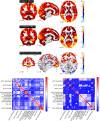Individual Brain Charting, a high-resolution fMRI dataset for cognitive mapping
- PMID: 29893753
- PMCID: PMC5996851
- DOI: 10.1038/sdata.2018.105
Individual Brain Charting, a high-resolution fMRI dataset for cognitive mapping
Abstract
Functional Magnetic Resonance Imaging (fMRI) has furthered brain mapping on perceptual, motor, as well as higher-level cognitive functions. However, to date, no data collection has systematically addressed the functional mapping of cognitive mechanisms at a fine spatial scale. The Individual Brain Charting (IBC) project stands for a high-resolution multi-task fMRI dataset that intends to provide the objective basis toward a comprehensive functional atlas of the human brain. The data refer to a cohort of 12 participants performing many different tasks. The large amount of task-fMRI data on the same subjects yields a precise mapping of the underlying functions, free from both inter-subject and inter-site variability. The present article gives a detailed description of the first release of the IBC dataset. It comprises a dozen of tasks, addressing both low- and high- level cognitive functions. This openly available dataset is thus intended to become a reference for cognitive brain mapping.
Conflict of interest statement
The authors declare no competing interests.
Figures



Comment on
-
Individual Brain Charting dataset extension, second release of high-resolution fMRI data for cognitive mapping.Sci Data. 2020 Oct 16;7(1):353. doi: 10.1038/s41597-020-00670-4. Sci Data. 2020. PMID: 33067452 Free PMC article.
References
Data Citations
-
- Pinho A. L., et al. . 2017. OpenfMRI. ds000244
References
-
- Thirion B. et al. Analysis of a large fMRI cohort: Statistical and methodological issues for group analyses. Neuroimage 35, 105–120. https://doi.org/10.1016/j.neuroimage.2006.11.054 (2007). - DOI - PubMed
-
- McNamee R. L. & Lazar N. A. Assessing the sensitivity of fMRI group maps. Neuroimage 22, 920–931. https://doi.org/10.1016/j.neuroimage.2004.02.016 (2004). - DOI - PubMed
-
- Fedorenko E., Behr M. K. & Kanwishera N. Functional specificity for high-level linguistic processing in the human brain. Proc Natl Acad Sci USA 108, 16428–16433. https://doi.org/10.1073/pnas.1112937108 (2011). - DOI - PMC - PubMed
-
- Nieto-Castañón A. & Fedorenko E. Subject-specific functional localizers increase sensitivity and functional resolution of multi-subject analyses. Neuroimage 63, 1646–1669. https://doi.org/10.1016/j.neuroimage.2012.06.065 (2012). - DOI - PMC - PubMed
-
- Frost M. A. & Goebel R. Measuring structural-functional correspondence: Spatial variability of specialised brain regions after macro-anatomical alignment. Neuroimage 59, 1369–1381. https://doi.org/10.1016/j.neuroimage.2011.08.035 (2012). - DOI - PubMed
Publication types
MeSH terms
LinkOut - more resources
Full Text Sources
Other Literature Sources

